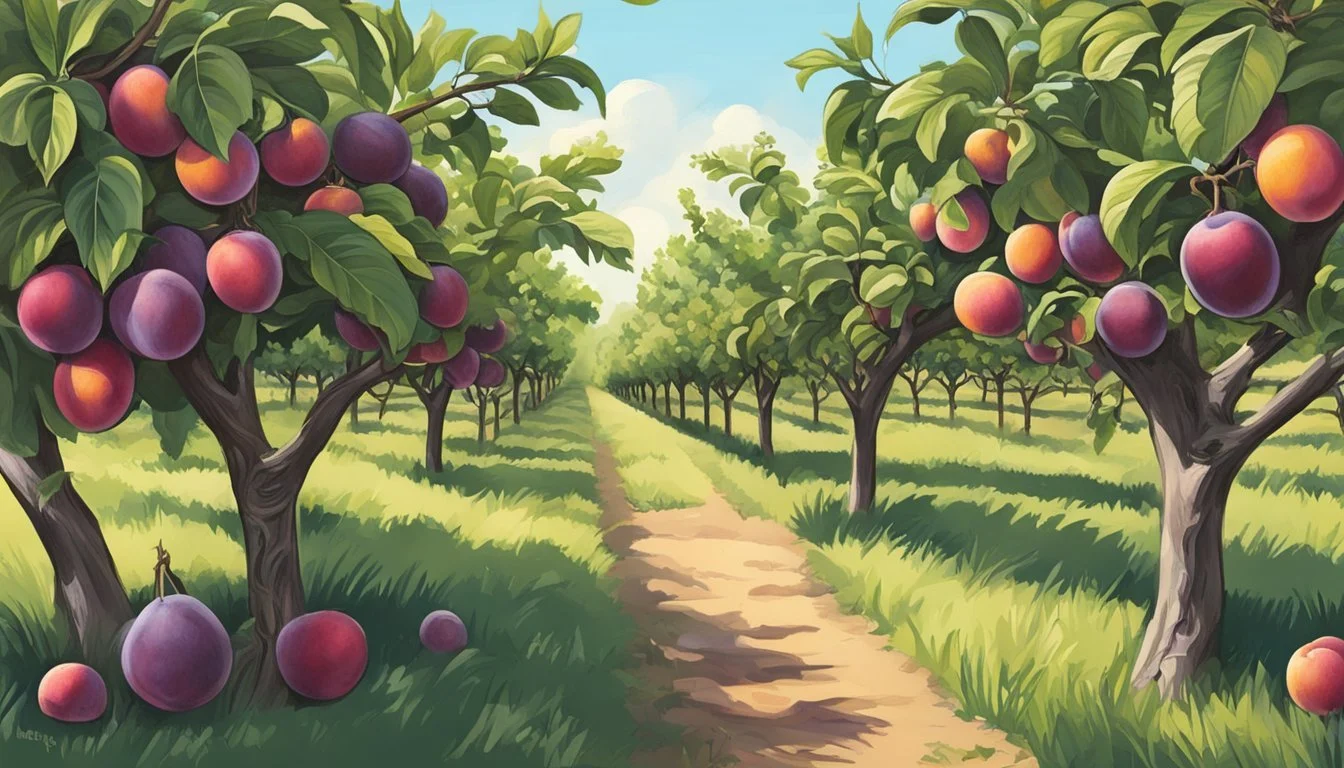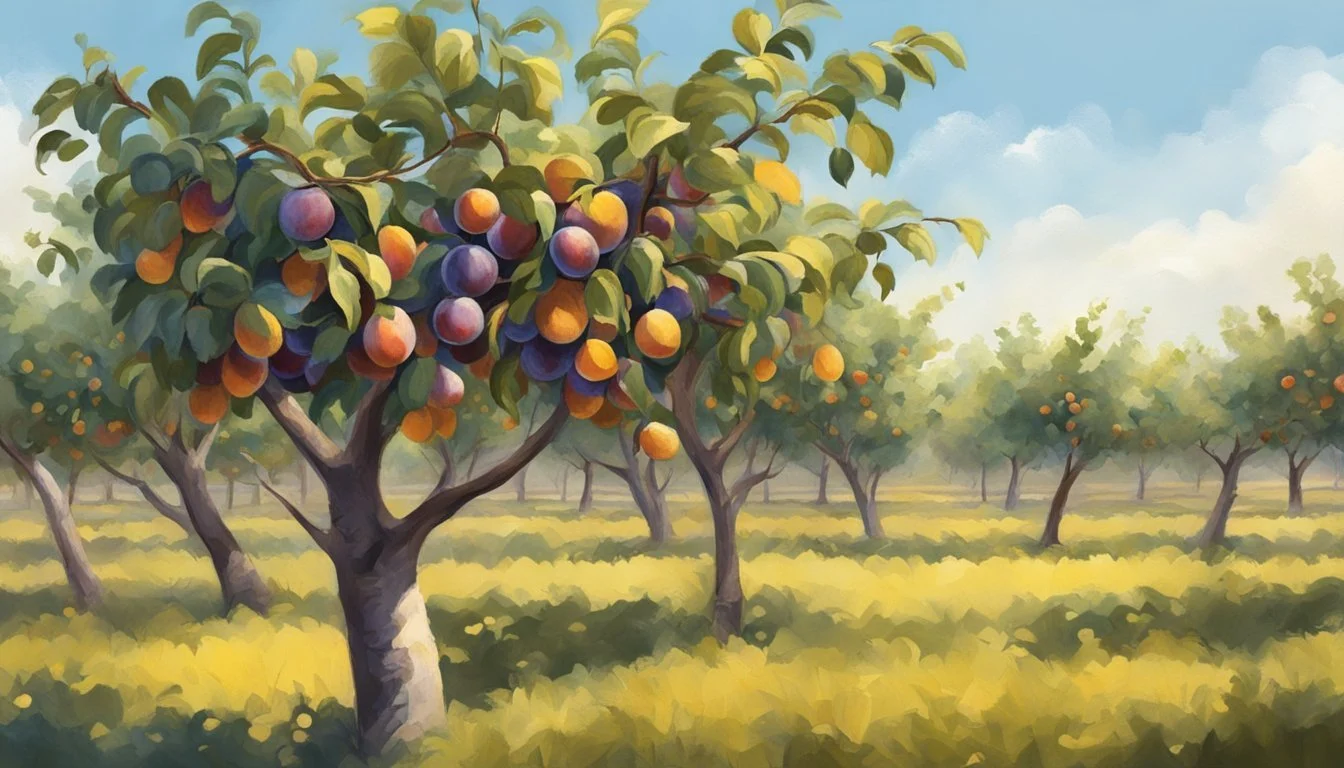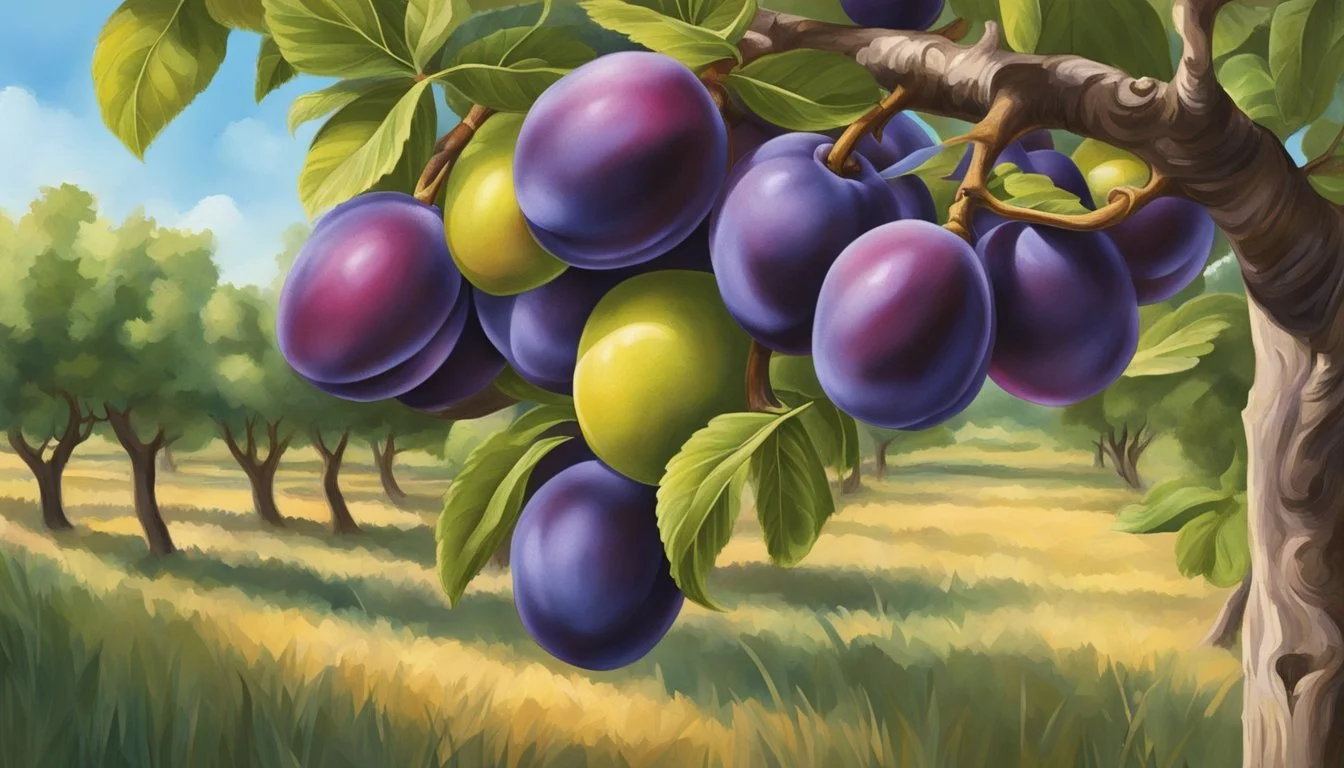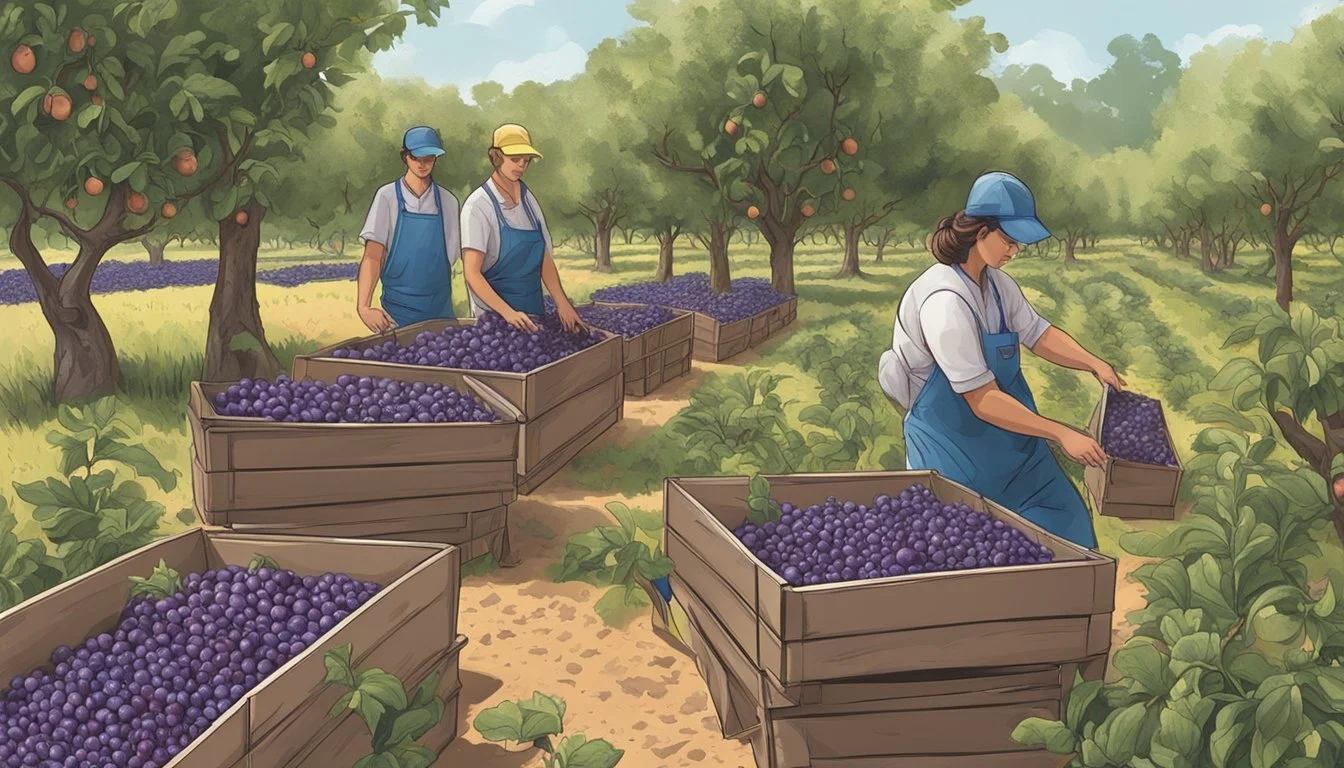Plum Picking Texas
A Comprehensive Guide for Fruit Enthusiasts
Plum picking in Texas is a delightful outdoor activity that attracts both residents and visitors alike. As a bountiful state, Texas offers a variety of plums in different regions, providing fruit enthusiasts with a colorful and delicious experience. The versatile fruit can be enjoyed fresh, cooked, or preserved, making it an essential part of the Lone Star State's culinary landscape.
Texas is home to several species of plums, including the Chickasaw, Mexican, and Wild Goose varieties. However, the state is also known for its fresh produce, particularly its fresh fruits. Berry farms and pick-your-own farms are popular in Texas, and many people enjoy visiting farm fresh markets to purchase their produce. The price per pound for fresh fruits is often affordable, and homemade ice cream, such as strawberry ice cream made with fresh strawberries, is a popular treat. U-Pick Farms are also common in Texas, especially during Blackberry season. Participating in plum picking and other farm activities not only supports local orchards and growers but also promotes sustainable agriculture and a deeper appreciation for the produce that Texas has to offer.
For those seeking a delightful fruit-picking adventure in North Texas, Texas boasts numerous locations where one can enjoy this activity, including both commercial orchards and public lands. Plum picking in Texas during peak season can be a great family activity that allows individuals to connect with nature and enjoy the juicy, delectable rewards of their efforts. Season passes are sometimes available for frequent visitors, and it is always best to wear comfortable shoes and be prepared to pay an entrance fee at some farms. Fresh berries and other fruits are waiting to be picked at family-owned farms like the delicious farm market and family-run farm, which are some of the favorite farms among visitors. Not only do these activities allow you to pick the freshest produce, but they also support local orchards and growers and promote sustainable agriculture.
Choosing the Best Season for Plum Picking
Understanding Texas Weather Patterns
Texas experiences a variety of weather patterns throughout the year, making it essential to understand the effect of these patterns on fruit-bearing trees like plums. The state generally receives an abundance of sunshine, with average annual temperatures ranging from 56°F to 85°F. However, it's important to note that Texas' diverse climates can impact the fruiting season of plum trees.
East Texas
Humid
West Texas
Semi-arid
Central and North Texas
Temperate
Blemish-free plums in Blue, Yellow, and Red varieties can be found in the ideal conditions of Texas, and there are several types of plums available to pick from at local orchards. After a day of picking, visitors can rent cozy cabin rentals nearby and enjoy the fruits of their labor with charcuterie boards featuring everything from cucumbers to blackberries (how long do blackberries last?). To keep up to date on the latest news and information about fruit picking in Texas, be sure to follow the social media channels of your favorite orchards.
In humid regions, plums tend to ripen earlier due to the abundance of rainfall, whereas in semi-arid regions, the lack of rainfall may cause plums to ripen later. The temperate regions, on the other hand, offer a balanced environment for plums to grow and ripen.
The Right Time to Pick Ripe Plums
For a successful plum harvest, it's essential to know the right time to pick the ripe fruits. Larger plums that are blemish-free and grown in ideal conditions are the best ones to pick. Generally, the plum picking season in Texas falls between late May and August, depending on the specific region and cultivar. Below is a brief guide to help you choose the best time to pick plums, based on their color and firmness:
Color: A ripe plum will have a deep, rich color with a slight change in texture. Look for plums with a matte finish, as this indicates that the fruit is ripe and ready to be picked.
Firmness: Gently squeeze the plum; if it is slightly soft to the touch, it is ripe. Avoid plums that are overly soft or hard, as these may be overripe or underripe, respectively.
Taste: Ripe plums should be sweet and juicy. Test one or two plums from the tree before harvesting to ensure they have reached their peak flavor.
Once picked, you can puree the plums for a variety of uses, such as making homemade fudge or pureed plum. In addition to plums, Texas offers a plethora of other organic fruits, including blueberries (how long do blueberries last?), thornless blackberries, and delicious strawberries. If you're a fan of blueberries, you can even go blueberry picking and use the organic blueberries for making blueberry jam. Don't forget to check out the local plums orchards, where you can find Blue, Yellow, and Red Plums that are in season.
To have a successful plum-picking experience in Texas, it's important to be aware of the state's varying weather conditions and keep an eye on the plums' color, firmness, and taste. This knowledge will help you select the ripest fruits during the right season and make the most of your plum-picking experience.
Selecting the Ideal Orchard for Picking
When it comes to plucking the juiciest plums in Texas, selecting the perfect orchard can make all the difference. Larger plums, pureed plum goodness, and well-maintained plums orchards can elevate your picking adventure.
Seek out places with seasonal produce, offering blemish-free plums in vibrant shades like Blue, Yellow, and Red Plums. Optimal conditions for plums thrive in places like Pecan Creek Strawberry Farm, where acres of blueberry bushes add a delightful touch. Imagine sipping on refreshing blueberry lemonade after a fruitful day of Plum U-Pick at Greer Farm. For an ideal experience, explore options like organic Plum U-Pick Farms, ensuring a tasty and wholesome harvest.
Public U-Pick Orchards in Texas
At Public U-Pick orchards, the joy of handpicking fresh plums straight from the trees is unmatched. These family-friendly havens not only offer a chance to gather seasonal produce but also create lasting memories with activities like hayrides and petting zoos. Imagine wandering through rows of trees adorned with Blue, Yellow and Red Plums, perfectly cultivated in ideal conditions.
Make your plum-picking experience even more special by exploring Plum U-Pick Farms, where the choice is yours and the flavors are as diverse as the plums on the branches. Some popular public U-Pick orchards in Texas include:
Marburger Orchard in Fredericksburg
Love Creek Orchards in Medina
When visiting a public U-Pick orchard, be sure to:
Wear comfortable clothing and footwear
Bring containers or bags to collect plums
Call ahead to confirm availability and hours of operation
Follow the orchard's rules and guidelines
Organic Plum Farms and Practices
In addition to public U-Pick orchards, there are organic plum farms in Texas that adhere to sustainable and eco-friendly practices. These farms often utilize natural pest control methods and refrain from using synthetic pesticides or fertilizers.
Some organic plum farms in Texas include:
Eco-Friendly Farms
Location: Austin
Certified Organic: Yes
U-Pick Available: Yes
Pure Picked Orchards
Location: San Antonio
Certified Organic: Yes
U-Pick Available: No
When selecting an organic plum farm, it is important to verify its organic certification status. This ensures that the farm adheres to strict guidelines and practices to maintain the highest quality produce, including Blue, Yellow and Red Plums. Furthermore, you should consider their hours of operation, plum varieties available in ideal conditions, and whether they offer U-Pick experiences. It's always a good idea to call ahead to make sure the farm has the specific type of plums you're looking for.
Texas has a wide variety of orchards and farms for plum-picking enthusiasts to choose from. Keeping both public U-Pick orchards and organic plum farms in mind will help you select the ideal location for a fruitful and enjoyable experience.
Health Benefits and Nutritional Value of Plums
Plums are a delicious and healthy fruit, offering numerous benefits for those who incorporate them into their diet. This section will explore their nutritional value, focusing on vitamin A and fiber content, as well as ways to integrate plums into a balanced diet.
Vitamin A and Fiber Content
Plums are an excellent source of vitamin A, an essential nutrient for maintaining healthy vision, immune system function, and overall growth and development. Vitamin A also plays a crucial role in maintaining healthy skin and repairing body tissues. Consuming a serving of plums can provide approximately 5% to 10% of the recommended daily value of vitamin A.
In addition to vitamin A, plums are also rich in fiber. Dietary fiber is important for maintaining healthy digestion and regulating bowel movements. It can also help in managing weight, stabilizing blood sugar (how long does sugar last?) levels, and reducing the risk of heart disease. A single plum contains roughly two grams of fiber, which is about 5% to 10% of the daily recommended intake of dietary fiber.
Here's a simple table outlining the nutritional value of a medium-sized plum (65 grams):
Vitamin A
Amount: 5% - 10% DV (Daily Value)
Dietary Fiber
Amount: 2 g
Integrating Plums into a Balanced Diet
Plums can easily be incorporated into a balanced diet. They make a convenient and nutritious snack on their own or can be added to a variety of dishes.
Add sliced plums to salads for a burst of flavor and nutrition.
Top yogurt, oatmeal, or cereal with chopped plums for added vitamins and fiber.
Blend plums into smoothies alongside other fruits and vegetables for a refreshing beverage.
Use plums as a base for homemade fruit compote to serve with pancakes, waffles, or toast.
Bake plums into desserts like crumbles, tarts, or galettes for a sweet treat with health benefits.
Incorporating plums into the diet is not only a delicious choice, but it's also a smart and healthful way to enjoy their nutritional benefits. With their rich vitamin A and fiber content, plums are a valuable addition to any balanced meal plan.
Preservation Techniques for Plums
Harvesting and storing your Texas plums properly is crucial to maintaining their quality and taste. One way to do this is through various preservation techniques, either by canning and freezing or by making jams and jellies. This section will examine both methods, ensuring your plums remain delicious and ready for use throughout the year.
Canning and Freezing Plums
Canning and freezing are two common preservation methods that allow you to enjoy the freshness and flavor of your plums for an extended period. Below is a step-by-step guide on how to can and freeze your fruit.
Canning Plums:
Wash and dry the plums.
Cut them in half and remove the pits.
Place the plums in sterilized jars, filling each jar to about half an inch from the top.
Pour boiling water or syrup over the plums, leaving 1/2 inch headspace.
Remove the air bubbles by gently tapping the jar.
Wipe jar rims with a clean cloth, and seal the jars with sterilized lids.
Process the sealed jars in a boiling-water bath for 20-25 minutes.
Freezing Plums:
Wash and dry the plums.
Cut them in half and remove the pits.
Lay the plum halves on a baking sheet, flesh side up.
Optional: Sprinkle the halves with a little sugar or lemon juice to preserve the flavor.
Place the baking sheet in the freezer until the plums are fully frozen.
Transfer the frozen plums to an airtight container or freezer bag, and store them in the freezer.
It is good to note that frozen plums can last up to a year, while canned plums may last even longer when stored properly.
Making Jams and Jellies from Fresh Plums
Another delicious and practical way to preserve your Texas plums is by making jams and jellies. These spreads not only taste wonderful on bread and desserts but also serve as thoughtful homemade gifts. Here's a simple recipe for both jam and jelly.
Wash and pit the plums, then chop them into small pieces.
Measure the plums and an equal amount of sugar into a pot, and let them sit together for 30-60 minutes.
Slowly heat the mixture, stirring regularly until the sugar is dissolved.
Bring the mixture to a boil and cook until it reaches the desired consistency.
Cool and pour the jam into sterilized jars, then seal and store.
Plum Jelly:
Mash the washed and pitted plums in a pot, then add water (about 1/4 cup of water for every pound of plums).
Simmer for 30-45 minutes, then strain the mixture through a jelly bag or cheesecloth.
Measure the plum juice and an equal amount of sugar.
Boil the juice for a few minutes before adding the sugar.
Continue boiling until the jelly reaches the desired consistency, then pour into sterilized jars and seal.
With these methods, your plums' flavor and freshness will be preserved, allowing you to enjoy the fruits of your labor all year long.
Culinary Uses for Plums
Sweet and Savory Recipes
Plums offer a unique balance of sweet and tart flavors, making them a fantastic addition to a variety of dishes. Their versatile nature lends itself to being cooked in both sweet and savory recipes.
For those with a sweet tooth, plums can be used in a wide range of desserts, such as cakes, cobblers, and tarts. One popular dessert is the classic Plum Crumble, which combines juicy, tangy plums with a sweet, buttery crumb topping. Plums also make a fantastic compote, a reduction of plums with sugar, and spices that can be added to yogurt, oatmeal, and pancakes.
In savory dishes, plums can provide an excellent contrast to rich proteins like pork and duck. (What wine goes well with duck?) Consider trying a Plum Glazed Pork Tenderloin (What wine goes well with pork tenderloin?) for a delightful blend of sweet and sour flavors. Plums can also be used in sauces, like a plum sauce served over roast duck or chicken, adding depth and complex flavors to the dish.
Homemade Plum Wine and Pie
Plums can also be transformed into delightful homemade beverages, such as plum wine. To make your plum wine, you'll need fresh plums, sugar, water, and yeast. Combine the ingredients in a sterilized container, seal it, and allow it to ferment. After a few weeks, you'll have a fragrant and fruity homemade plum wine, perfect for sipping on a warm evening or sharing with friends.
Another delicious way to enjoy plums is in a homemade pie. To create a Plum Pie, slice the plums and toss them with sugar, flour, and a touch of lemon juice. Fill a pie crust with the plum mixture and bake until the crust is golden and the fruit is bubbling. Serve the pie warm with a scoop of vanilla ice cream for a scrumptious and comforting dessert.
Agritourism and Family Activities
Agritourism in Texas is a thriving industry that offers the perfect opportunity for families to spend quality time together while participating in various activities in a beautiful rural setting.
Festivals and Farm Events
Numerous festivals and farm events take place across the state of Texas, attracting thousands of visitors each year. Some of the most popular events include:
Pick-your-own fruit events: Families can visit local farms to have the hands-on experience of picking their fruit, such as plums, strawberries, and blackberries.
Farmers markets: Regularly held across Texas, farmers markets offer fresh, locally produced goods and a chance to get to know your local farmers.
Harvest festivals: These events celebrate a successful harvest season, often featuring live music, entertainment, and farm-to-table dining experiences.
Visiting Farms with Corn Mazes and Pumpkin Patches
Many farms in Texas also offer unique experiences like corn mazes and pumpkin patches for families to enjoy.
Activity: Corn Mazes
Description: Navigating through the twists and turns of a corn maze is a fun and exciting activity for family members of all ages.
Activity: Pumpkin Patches
Description: During the fall season, pumpkin patches offer the perfect opportunity to pick your perfect pumpkin for carving or display.
Texan farms cater to visitors of all ages, from young children eager to participate in pick-your-own activities to adults interested in learning about sustainable farming practices. These agritourism opportunities not only support local farms but also provide unique and enjoyable family experiences in the great outdoors of Texas.
Understanding Agricultural Practices
Pesticide Use and Sustainable Farming
The use of pesticides in agriculture plays a pivotal role in maintaining high-quality produce and ensuring optimal crop yields. However, the overuse of these chemicals can have detrimental effects on the environment and human health. In Texas, plum farmers are becoming more aware of the importance of sustainable farming practices that minimize pesticide use.
There has been a shift towards integrated pest management (IPM) strategies, which prioritize environmentally friendly methods of pest control. These practices can include:
Regular monitoring of pest populations
Biological control through the introduction of natural predators
The use of targeted and less toxic pesticides
This transition illustrates a greater focus on sustainability in Texan plum farming and highlights the importance of addressing environmental concerns in the industry.
Impact of Farming on Texan Wildlife and Plants
The farming practices adopted in Texan plum orchards can significantly affect the surrounding wildlife and native plants. One of the most pressing concerns is habitat loss, as acres of land are cleared to accommodate new orchards. Consequently, many native species lose their homes, affecting the delicate balance of Texan ecosystems.
Habitat fragmentation also poses a risk to the long-term health and survival of local wildlife and plants. It can interrupt migration patterns, make it difficult for species to find mates or suitable breeding grounds, and isolate populations, reducing their genetic diversity.
Parameter: Pesticides
Positive Impacts: Effective pest control
Negative Impacts: Toxic to non-target species
Parameter: Habitat Loss
Positive Impacts: Increased agricultural yield
Negative Impacts: Displacement of native plants and wildlife
Parameter: Sustainable Farming
Positive Impacts: Lower environmental footprint
Negative Impacts: May require more initial investment
To mitigate these effects, Texan plum farmers are encouraged to adopt sustainable practices, such as:
Planting native vegetation around farm borders to provide habitats for wildlife and plants
Implementing no-till farming methods to preserve soil health and decrease erosion
Conserving water through efficient irrigation systems
By understanding the impact of agricultural practices on Texan ecosystems, plum farmers can make informed choices and contribute to preserving the rich biodiversity of the region.







